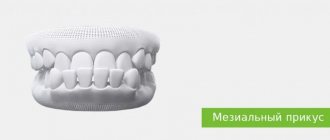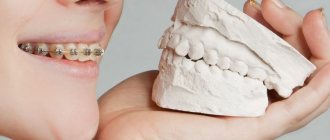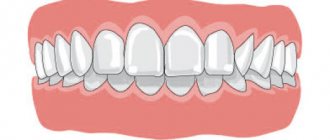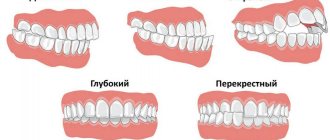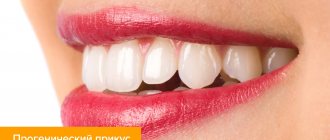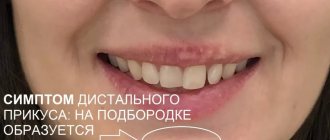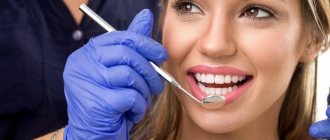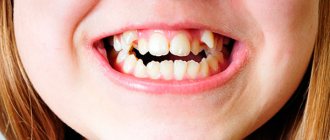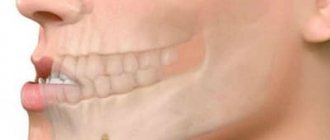Progeny is a deviation from the norm in the structure of the dentition. It is expressed in enlargement and protrusion of the lower jaw. Such pathological deformation occurs statistically in the range of 1.4 - 30% of patients.
External signs:
In addition to a protruding lower jaw, patients with pathology experience:
- recession of the face in the middle part;
- thickening of the lower lip relative to the upper, its protrusion, and sometimes inversion;
- deepened nasolabial folds;
- increased angle between the lower and upper jaw.
Why is progeny dangerous?
With progenia, the process of chewing, digesting and assimilation of food is disrupted. A person with a severe pathology experiences difficulty while eating, sometimes even cannot take a full bite, which leads to increased stress on the gastrointestinal tract.
There is a redistribution of the load on the teeth, as a result of which some of them wear out faster and require frequent treatment. In addition, the proportions are disrupted and the appearance of the face changes. Such an aesthetic defect in childhood can cause complexes and isolation in a child.
Impairments in oral breathing also appear. The consequence of this is an increased incidence of colds, periodic chapping of the lips and dryness of the oral mucosa.
What is progeny of the jaw?
This is a type of jaw disorder in which the lower jaw, chin and lower lip protrude significantly forward, and the upper lip may recede. The teeth of the lower row overlap the teeth of the upper row when the patient closes the jaw. This type of defect is also called mesial malocclusion. There are different degrees of severity of this defect - from a slightly protruding chin, like Arnold Schwarzenegger, to a condition in which there is a very strong disproportion between the upper and lower jaws.
Interesting fact!
A slight degree of progeny of the lower jaw in the case of men is considered a sign of a particularly masculine appearance.
So, maybe this defect is not worth fixing? It is important to understand here that any malocclusion, even if it seems harmless, can lead to a number of unpleasant consequences - both for the health of the oral cavity and for the body as a whole:
- increased abrasion of enamel;
- higher risk of developing caries;
- disorders of the temporomandibular joint;
- discomfort or even pain when opening the mouth and (or) chewing;
- headaches, neck pain, insomnia;
- diction defects;
- disproportions and asymmetries of facial features.
Classification of progeny
Pathology is divided into false and true.
In cases of true progeny, the lower jaw develops to a greater extent. In patients with this type, diction is impaired and all external signs of pathology are present. The appearance is influenced by genetic factors, birth injuries and diseases of the woman during pregnancy. It is important to begin treatment at an early age, while the maxillofacial bones can be corrected. Corrective measures are limited to delaying the development of the lower jaw, using massage, and sometimes surgical intervention. In adulthood, adjustments are more difficult. You will need surgery and wearing an orthodontic device.
False progeny is characterized by normal jaw size. In this case, the lower one is shifted forward. Such a bite is formed when a person has to push it forward, as a result of which the muscles and ligamentous apparatus develop incorrectly. The causes are prematurely lost or removed milk teeth in the upper jaw, delayed replacement of teeth, or constant fixation of the lower facial region in the wrong position.
Causes of progeny
Depending on its origin, progeny is divided into congenital (hereditary) and acquired. In the second case, factors contributing to changes in bite are:
- abnormalities in the structure of the pharynx, leading to breathing problems in a child of early years;
- birth injuries;
- edentulous upper jaw;
- the presence of supernumerary teeth on the lower jaw;
- habit of sucking your finger, tongue or upper lip;
- acromegaly;
- calcium metabolism failures resulting from various diseases;
- improperly attached or shortened frenulum of the tongue;
- habit of sleeping with your head on your chest;
- uneven wear of baby teeth during the period of mixed dentition;
- hyperfunction of the pituitary gland;
- macroglossia;
- the habit of sitting with your lower jaw supported by your hands;
- excessive passion for pacifiers and pacifiers;
- poorly performed surgical operations.
Correction of bite during progenia
The choice of correction methods depends on the type of pathology and the causes of its occurrence. The orthodontic appliances used stimulate the development of the upper jaw and correct the position of the teeth. DaVinci studio dentists use:
- mouthguards;
- trainers;
- plates.
These are less painful and long-lasting methods of correction. When starting treatment in adulthood, the braces system will help you achieve the desired result. Children wear them from one to one and a half years, while adults wear them for about four years.
Serious dental deformities in the absence of a desire to use braces are treated with surgical intervention in adulthood. Surgery is a financially expensive method associated with the risk of complications. Therefore, if a dentist recommends wearing orthodontic appliances, it is better to listen to the advice.
Signs of progeny
When seeking help from an orthodontist, many patients focus primarily on an unattractive appearance of their smile or face. In this regard, it is not difficult to identify dental progeny - it is characterized by:
- unaesthetic appearance of teeth and smile - the upper front teeth are completely or partially hidden behind the lower ones;
- lack of contact when the teeth of the upper and lower jaws meet - a gap is visible between them, sometimes up to 10 millimeters wide;
- the lower jaw is significantly longer than the upper and protrudes noticeably forward, especially when looking at the face in profile;
- When chewing, the patient experiences painful or uncomfortable sensations.
There are 2 types of this defect:
- true progeny is an increase in all or most parameters of the lower jaw and dentition;
- false progeny - when the size of the bone in the lower jaw is normal, but there is either underdevelopment of the upper jaw or a forward displacement of the lower jaw while maintaining normal size.
Prevention
If the pathology is not congenital, the formation of a pathological bite can be avoided by taking timely measures:
- Plan your first visit to the dentist when the child is 2-3 years old;
- stop smoking and drinking alcohol (even in small doses) while planning pregnancy and while carrying a baby;
- prevent the development of bad habits: wean your baby off thumb sucking, get rid of pacifiers and bottles in a timely manner;
- From early childhood, teach to keep your posture straight, since the interconnection of all systems in the body has been proven. Slouching changes the tilt of the head, which contributes to the constant advancement of the lower jaw forward;
- Monitor the position of the child's head during sleep. The child should not get used to placing a pillow or fist under it. Excessive pressure on the jaw creates an incorrect bite. You should also avoid throwing your head back or pressing your head to your chest.
The main signs of progeny are a signal for immediate contact with the dentist. Pay special attention to your child, because it is in childhood that pathology is easy to correct.
Add a comment
Leave your comment
Treatment of progenia
Treatment of pathology at a young age
In the early stages of the disease, it is much easier to stop the development of the pathological process.
Treatment of progeny in young children comes down to the following measures in dentistry:
- eliminating factors influencing the formation of malocclusion;
- massage of the anterior zone of the alveolar process located on the upper jaw;
- correction of a shortened frenulum of the tongue;
- combating bad habits (through the use of the vestibular plate);
- normalizing the functions of swallowing, chewing, breathing and speech (using labial activators, training the orbicularis oris muscle);
- artificially establishing the child’s incisors in marginal closure by grinding their cutting edges (the technique is used to treat children under 4 years of age with a slight reverse overlap);
- the use of the Bruckle device and a cap with a chin sling and an extraoral rubber rod to displace the lower jaw (advisable for deep incisal reverse overlap);
- the use of plates with protracting springs located on the vestibular or palatal surface of the central incisors during the eruption of the latter;
- the use of occlusal pads in the presence of incisal reverse overlap not exceeding 2 mm;
- the use of the Wunderer activator, the Bashirova apparatus, the Hoffman activator, the Schwarz double plate, the Andersen-Goipl activator, the functional Boule apparatus and the Frenkel clasp activator for the treatment of severe dentoalveolar types of pathology.
Treatment of pathology in adolescents
Treatment of progenia in persons with a formed permanent dentition requires much more effort and time than treatment of this pathology in children. At the same time, to correct the bite in adolescents in orthodontics, the same devices are most often used as in the period of temporary occlusion, however, dentists in this case opt for the use of fixed devices.
Treatment of the disease in adults
In case of severe progeny in adults, the Brückle apparatus, arc devices with intermaxillary traction and brace systems can be used.
In this case, orthopedic treatment of pathology is reduced to the following measures:
- displacement of the lower jaw teeth lingually, and the upper jaw labially (using a wire ligature, protraction springs and devices operating on the principle of an inclined plane);
- reducing the length of the lower row of teeth by removing some teeth or eliminating spaces between them, as well as lengthening the upper row by moving the front teeth forward;
- sagittal displacement of both dentitions in the required directions.
If necessary, the fight against progeny can be carried out using a combined hardware-surgical method.
Diagnosis of mesial occlusion
The severity and complications associated with malocclusion can be fully identified only by an orthodontist. For this purpose, various diagnostic procedures are carried out: examination of dental occlusion, functional tests, measurement of anthropometric parameters of the face. Progeny of the lower jaw can be true or false.
- True progeny
This is considered to be the case when the lower jaw is pushed forward due to its increased size.
- At false progeny
there may not be anatomical overdevelopment of the lower jaw, but progeny occurs due to displacement of the jaw as a result of disorders in the articular apparatus or nasopharynx.
Treatment of mesial occlusion
Treatment of mesial occlusion can be carried out both in early childhood and at the stage of mixed dentition. For this, various orthodontic devices are used: trainers, mouthguards, aligners, plates... In case of congenital shortening of the frenulum, the problem can be solved with the help of frenuloplasty.
Orthodontic methods
They allow both to accelerate the growth of the upper jaw to compensate for the underdevelopment of the lower jaw, and to slow down the development of the lower jaw. In cases where mesial occlusion is hereditary, the orthodontist’s task is to bring the bite to correct occlusion in order to prevent excessive wear of the teeth and disturbances in chewing food.
Due to mesial occlusion, the child may experience speech therapy problems. Such children should be treated carefully. Often the problem can be solved without drastic measures: with the help of myogymnastics, massage, classes with a speech therapist. Surgical treatment is rarely prescribed for children.
After the child has replaced his teeth with permanent ones, orthodontic treatment can be carried out with braces. At this age, the bones of the skeleton are still growing and are susceptible to plastic deformation; with the help of braces, results can be achieved in 1-2 years.
Reasons for the development of pathology
Despite the eloquent definition, the development of pathology is observed in patients of different age groups, which is due to the variety of causes of its occurrence. Congenital factors include:
- Illnesses suffered by the mother during pregnancy in the later stages;
- Genetic abnormalities and chronic predisposition;
- Injury during childbirth, as well as the use of contraindicated medications;
- The presence of a congenital cleft palate or abnormal development of the dentition;
- Pathological changes in the structure of the alveolar processes.
Factors classified as acquired include:
- Bad habits associated with constant pressure on the dentition;
- Long-term attachment to a pacifier or bottle;
- Slow process of bite change;
- Bruxism is uncontrollable grinding of teeth during sleep;
- Regular long-term maintenance of incorrect posture, which increases pressure on the teeth.
Such factors, despite their apparent insignificance, lead to a slow development of progeny, which becomes more active with the loss of several elements of the dentition.
TREATMENT
Treatment of progenia is carried out by an orthodontist. For children in the process of jaw growth, myofunctional gymnastics and massage of the alveolar process of the upper jaw are used. If necessary, plastic surgery of the frenulum of the tongue is performed, and special mouthguards and devices are used according to indications. For permanent occlusion, a brace system is indicated. Speech therapy classes are conducted in conjunction with treatment. Sometimes, with excessive pathology, there is a need for surgical treatment.
